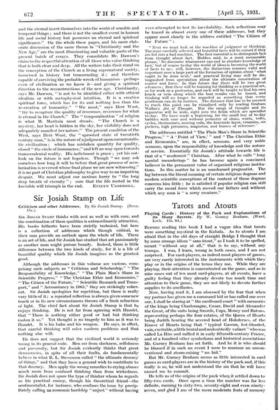Tarots and Atouts
BEFORE reading this book I had a vague idea that tarots were something mystical in the Kabala. As to atouts I am
afraid that in the old days of straight Bridge I thought that by some strange idiom " sans stout," as I took it to be spelled, meant " without any at all," that is to say, without any trumps. I was, I learn, wrong in both cases, and I am not surprised. For card-players, as indeed most players of games, are very rarely interested in the instruments with which they play or in the origins of the terms they use. While they are playing, their attention is concentrated on the game, and as in nine cases out of ten most card-players, at all events, have a guilty feeling that they already devote too much time and attention to their game, they are not likely to devote further supplies to its ancillaries.
Now, having read it, I am obsessed by the fear that when my partner has given me a command bid or has called one over one, I shall be staring at " the cardboard court " with memories of the kings being Charlemagne, Caesar, David and Alexander the Great, of the suits being Swords, Cups, Money and Batonsf representing perhaps the four estates, of the Queen of Hearts being Judith bearing the severed head of Holofernes, of the Knave of Hearts being that " typical Gaston, hot-blooded, vain, excitable, a little brutal and undoubtedly valiant" who was called La Hire and ruffled it in early fifteenth-century France, and of a hundred other symbolisms and historical associations Mr. Gurney Benham has set forth. And he it is who should be blamed if in such an event I were to murmur an uncon- ventional and storm-raising " no bid."
But Mr. Gurney Benham seems as little interested in card games as card-players are in the history of the pack and, if this really is so, he will not understand the sin that he will have caused me to commit.
He tells us of the origins of the pack when it settled down to fifty-two cards. Once upon a time the number was far less definite, running to sixty-two, seventy-eight and even ninety- seven, and glad I am of the more moderate feats of memory required for these later days. For quite a long time there were fifty-six cards, since, besides the king and queen of each suit, there were also the knight and the valet, the ousting of the former by the latter being presumably evidence of the decline of chivalry. I admit to a sense of relief at finding that the invention of cards was not due to the desire to amuse the insane Charles VI. That legend had always given me a feeling of nervousness, because I myself am very definitely amused, not to say absorbed, by playing with them. They are far, far older and more sane in origin than that, though whether Africa or Asia is responsible for their origin is not clear.
The earliest known packs seem to have been made in Italy and France, and it was in France that the industry mainly until recent years became established and flourished. But it flourished with difficulty because, as often happens, the authorities saw a splendid opportunity of reaping revenue and salving their consciences in regard to vice by imposing heavy taxes, selling exclusive licences and adopting the other governmental devices so useful for the attainment of the best of both worlds.
England, however, was not far behind the Continent in the industry and it is clearly shown that from the sixteenth century onwards, at all events, it was a thriving trade with from 1628 a worshipful company of its own, that dines and wines and performs to this very day whatever other functions worshipful companies do perform. And, despite all taxes and other difficulties, so well and truly have the cardmakers toiled that, while at first they drew their inspiration and their designs from France, they gradually so improved upon the originals that the French makers to-day advertise their cards as being of English design.
The only two uses for cards of which Mr. Gurney Benham speaks are for telling fortunes and for assisting, when the pack becomes incomplete, in the binding of old books. The latter use, due to the rarity of cardboard three hundred years ago, has been responsible for the recovery of numbers of quaint and interesting cards very many of which figure in the illustrations to this volume. In regard to those illus- trations and other matters of production it is a pity that the publishers or, at all events, the printers, have not done their work as well as the author. For he has produced a classic and an eminently readable classic at that. He has gathered together immense stores of learning and has set it forth pleasantly. They, on the other hand, have produced the book poorly and carelessly, with faulty registration of the colours, with uneven inking, often with dirty type, on a thick but not opaque paper. Still the book is cheap and that is a great deal, and it will, I venture to prophesy, win out







































 Previous page
Previous page